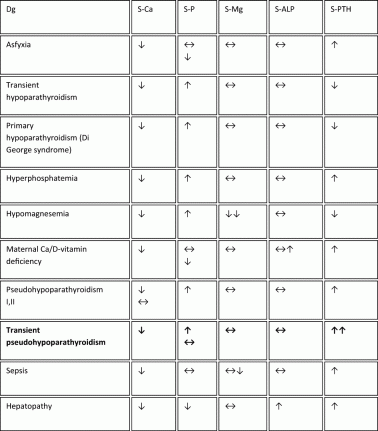ICCBH2017 Poster Presentations (1) (209 abstracts)
Neonatal hypocalcemia – transient neonatal pseudohypoparathyroidism
Stepan Kutilek 1, , Martina Vracovska 1 , Richard Pikner 2, & Zlatka Fejfarkova 2
1Department Pediatrics, Klatovy Hospital, Klatovy, Czech Republic; 2Department of Clinical Biochemistry, Klatovy Hospital, Klatovy, Czech Republic; 3Bone Disease Center, Klatovy Hospital, Klatovy, Czech Republic.
Background: Neonatal hypocalcemia is defined as S-Ca <2 mmol/l in fullterm newborns and <1.75 mmol/l in preterm newborns. Neonatal hypocalcemia is either early onset (<3 days of age) or late onset (>3 days of age). Newborns with hypocalcemia are often asymptomatic, but mays present with hypotonia, apnea, poor feeding, jitteriness, seizures, cardiac failure. Signs of hypocalcemia rarely occur unless S-Ca drops below 1.75 mmol/l.
Case presentation and clinical management: We present three boys (two with gestational age 39 weeks, one 36 weeks; none of them with either asfyxia or sepsis) with mild hypotonia, where S-Ca in the range of 1.67–1.9 mmol/l was detetectd within the first three days of life, together with hyperphosphatemia (S-P 2.5–2.6 mmol/l), normomagnesemia (S-Mg 0.77–0.88 mmol/l), normal alkaline phosphatase activity (S-ALP 2.8–4.5 μkat/l) and high S-PTH (40–51 pg/ml; normal 5–28). In spite of i.v. calcium supplementation and increase in S-Ca within 2–6 days, the elevated S-PTH persisted until day 6, together with normal or low-to-normal S-Ca, high or normal-to-high S-P and no increases in S-ALP. The mothers’ S-Ca, P, Mg, ALP, PTH levels were within normal reference ranges.
Discussion: Neonatal hypocalcemia can be a result of hypoparathyroidism (transient or primary), increased serum calcitonin, sepsis, asfyxia, hepatopathy, hypomagnesemia, high phosphate load and, rarely, transient neonatal hypoparathyroidism (transient resistance to biological actions of parathyroid hormone – PTH; 38 children reported so far). With regard to Table 1, the diagnosis of transient pseudohypoparathyroidism (due to immaturity of PTH-receptors) is suggestive and highly probable in these three neonates.
Table 1 Differential diagnosis of neonatal hypocalcemia.

Disclosure: The authors declared no competing interests.




